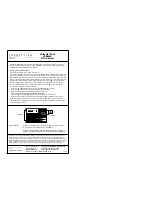
37
ENGLISH
16
ADDITIONAL INFORMATION
Optimum surround sound for different sources
There are currently various types of multi-channel signals (signals or formats with more than two channels).
2
Types of multi-channel signals
Dolby Digital, Dolby Pro Logic, DTS, high definition 3-1 signals (Japan MUSE Hi-Vision audio), DVD-Audio,
SACD (Super Audio CD), MPEG multi-channel audio, etc.
“Source” here does not refer to the type of signal (format) but the recorded content. Sources can be divided
into two major categories.
2
Types of sources
•
Movie audio
Signals created to be played in movie theaters. In general sound is recorded to be played
in movie theaters equipped with multiple surround speakers, regardless of the format
(Dolby Digital, DTS, etc.).
FL
C
SW
FR
FL
C
SW
FR
SL
SR
SB
SL
SR
SB
Multiple surround speakers
(For 6.1-channel system)
Movie theater sound field
Listening room sound field
In this case it is important to achieve the same
sense of expansion as in a movie theater with the
surround channels.
To do so, in some cases the number of surround
speakers is increased (to four or eight) or speakers
with bipolar or dipolar properties are used.
SL: Surround L channel
SR: Surround R channel
SB: Surround back channel (1 spkr or 2 spkrs)
•
Other types of audio
These signals are designed to recreate a 360° sound field using three to five
speakers.
In this case the speakers should surround the listener from all sides to create a
uniform sound field from 360°. Ideally the surround speakers should function as
“point” sound sources in the same way as the front speakers.
FL
C
SW
FR
SL
SR
These two types of sources thus have different properties, and different speaker settings, particularly for the
surround speakers, are required in order to achieve the ideal sound.
NOTES:
• If step 3 does not work, start over from step 1.
• If the microprocessor has been reset, all the button settings are reset to the default values (the values set
upon shipment from the factory).
1, 2
2
15
INITIALIZATION OF THE MICROPROCESSOR
When the indication of the display is not normal or when the operation of the unit does not shows the reasonable
result, the initialization of the microprocessor is required by the following procedure.
1
Switch off the unit using the main unit’s power
switch.
2
Hold the following SPEAKER A button and B
button, and turn the main unit’s power switch.
3
Check that the entire display is flashing with an
interval of about 1 second, and release your
fingers from the 2 buttons and the microprocessor
will be initialized.
14
LAST FUNCTION MEMORY
• This unit is equipped with a last function memory which stores the input and output setting conditions as they
were immediately before the power is switched off.
This function eliminates the need to perform complicated resettings when the power is switched on.
• The unit is also equipped with a back-up memory. This function provides approximately one week of memory
storage when the main unit’s power switch is off and with the power cord disconnected.
RT (Radio Text)
“RT” appears on the display when radio text data is
received.
When the RT button is pressed while receiving an RDS
broadcast station, the text data broadcast from the
station is displayed. To turn the display off, press the
RT button again. If no text data is being broadcast,
“NO TEXT DATA” is displayed.
“RT”
Summary of Contents for AVR-2105
Page 293: ...293 MEMO...
Page 294: ...294 MEMO...
Page 295: ...295 MEMO...
Page 296: ...TOKYO JAPAN www denon com Printed in China 511 4183 009...
















































